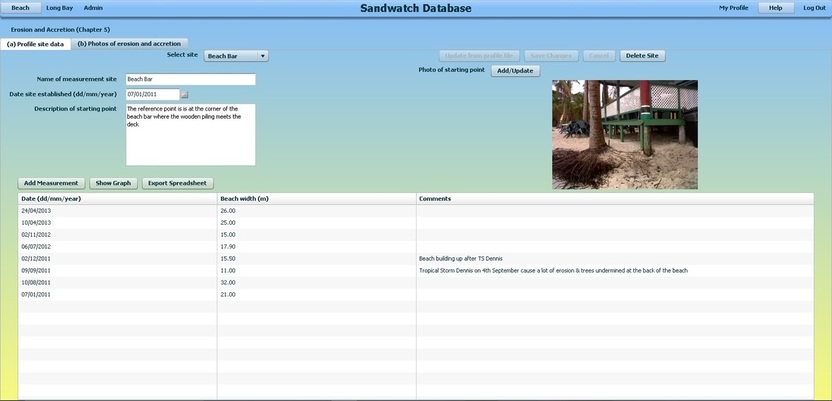About the Sandwatch International Database
(December 2020) The Sandwatch International Database is temporarily down until sometime next year. Adobe Flash Player is being discontinued December 31, 2020 and as a result we are having to re-configure access and storage for the database.
Aims
The Sandwatch International Database, https://sandwatchdb.org/beachdata/, launched in March 2013, has been specifically designed as a user-friendly tool for Sandwatch groups. There are three main objectives:
Aims
The Sandwatch International Database, https://sandwatchdb.org/beachdata/, launched in March 2013, has been specifically designed as a user-friendly tool for Sandwatch groups. There are three main objectives:
- Provide a teaching tool for students showing how the monitoring data can be analysed and displayed so as to show environmental changes over time and provide information for the design of tangible beach-related activities – the fourth step of the MAST approach - “Taking action”.
- Act as a permanent and safe archive for the monitoring data collected by Sandwatch groups over time.
- Facilitate the sharing of Sandwatch data to interested parties.
About the Database
The Sandwatch International Database follows the chapters in the Sandwatch Manual and specifically:
Database Users
There are two main types of Database Users:
1. Sandwatch Users: These are individuals actively undertaking Sandwatch monitoring and collecting data. There are different types of Sandwatch Users:
2. Guests: These are individuals who are not directly undertaking Sandwatch monitoring but would like to view the Database
TO OBTAIN A USERNAME AND PASSWORD AS A SANDWATCH USER OR A GUEST SEND AN EMAIL TO [email protected]
Database Tools
There are several tools to help new users and guests; these include a user’s guide, tutorials on selected chapters, and a video on getting started.
The Sandwatch International Database follows the chapters in the Sandwatch Manual and specifically:
- General Description (Chapter 4)
- Erosion and Accretion (Chapter 5)
- Beach Composition (Chapter 6)
- Human Activities on the Beach (Chapter 7)
- Beach Debris (Chapter 8)
- Water Quality (Chapter 9)
- Waves Characteristics (Chapter 10)
- Currents (Chapter 11)
- Plants and Animals (Chapter 12)
- Weather Measurements (Chapter 2)
Database Users
There are two main types of Database Users:
1. Sandwatch Users: These are individuals actively undertaking Sandwatch monitoring and collecting data. There are different types of Sandwatch Users:
- Beach Administrator
- Beach Editor
- Beach Viewer.
2. Guests: These are individuals who are not directly undertaking Sandwatch monitoring but would like to view the Database
TO OBTAIN A USERNAME AND PASSWORD AS A SANDWATCH USER OR A GUEST SEND AN EMAIL TO [email protected]
Database Tools
There are several tools to help new users and guests; these include a user’s guide, tutorials on selected chapters, and a video on getting started.
- Sandwatch Database User’s Guide v 1.3
- Tutorial on Getting Started
- Tutorial on Chapter 4 Beach Description
- Tutorial on Chapter 5 Erosion and Accretion
- Tutorial on Chapter 7 Human Activities
- Short video on Getting Started
TO GET HELP WITH USING THE DATABASE
SEND AN EMAIL TO [email protected]
SEND AN EMAIL TO [email protected]
